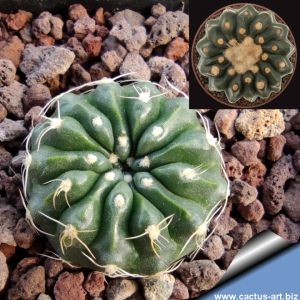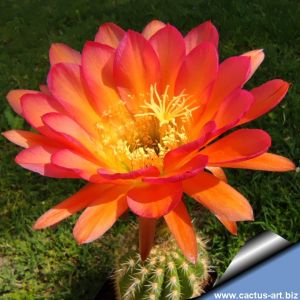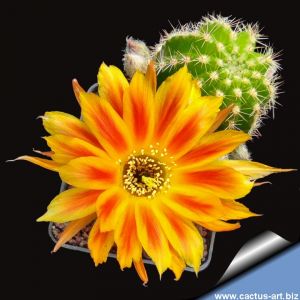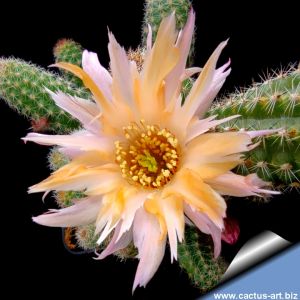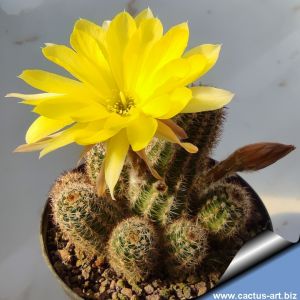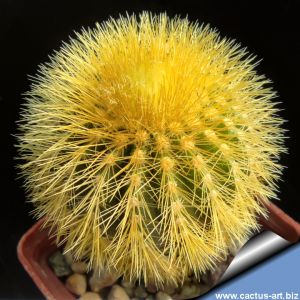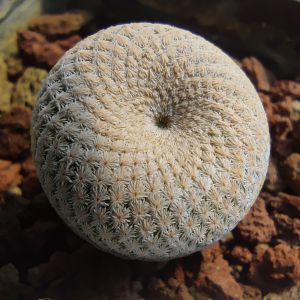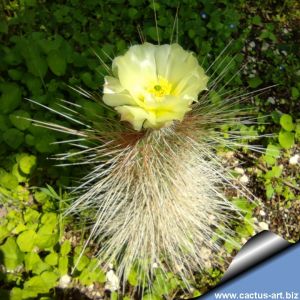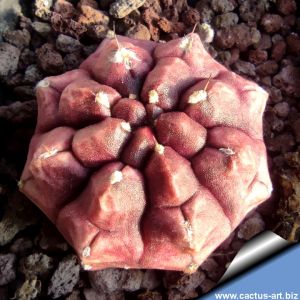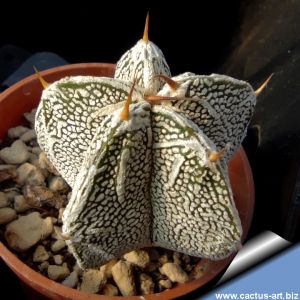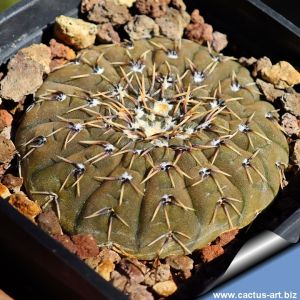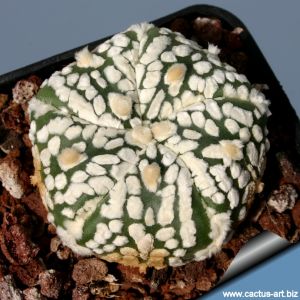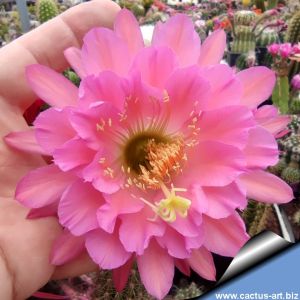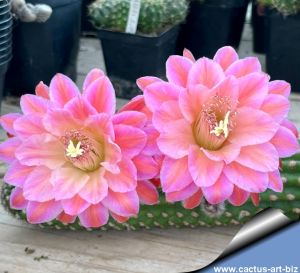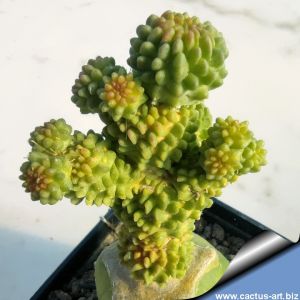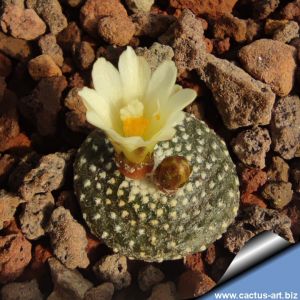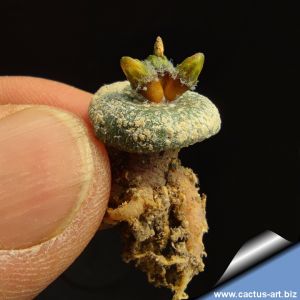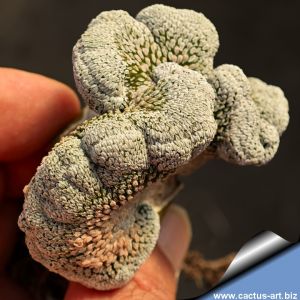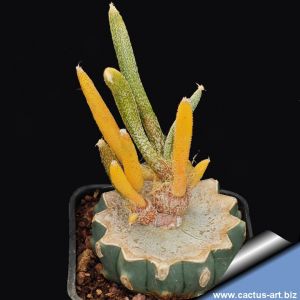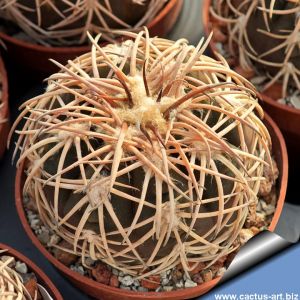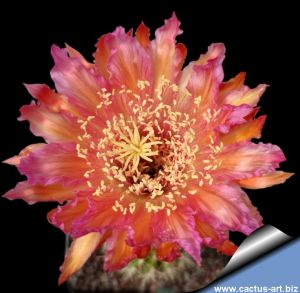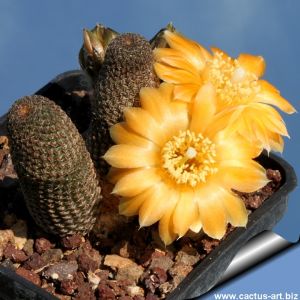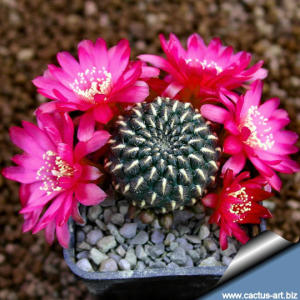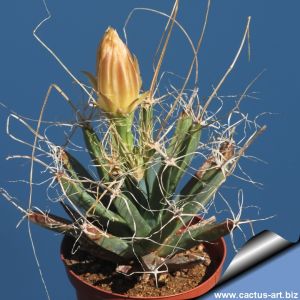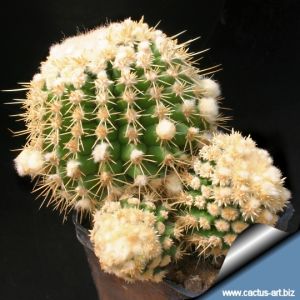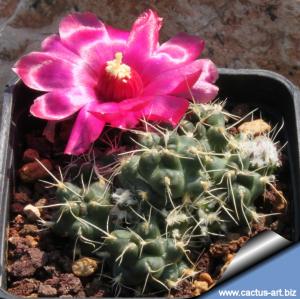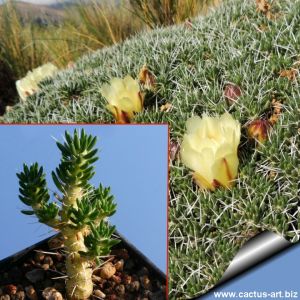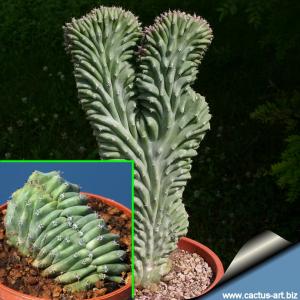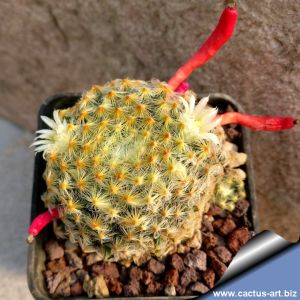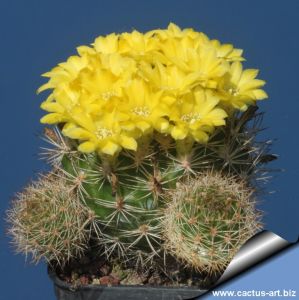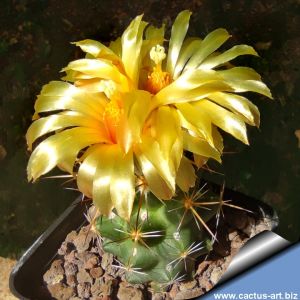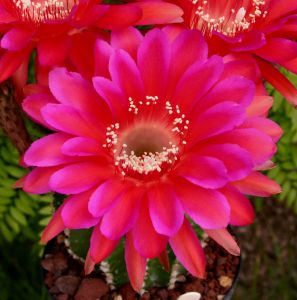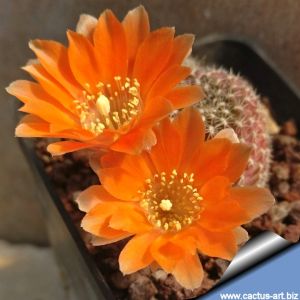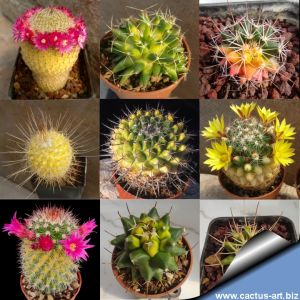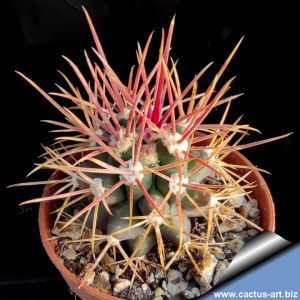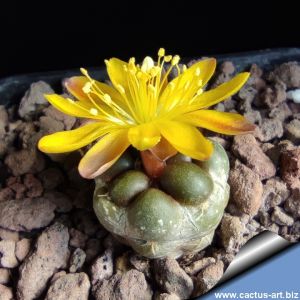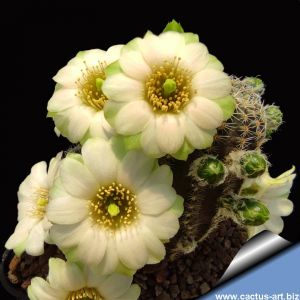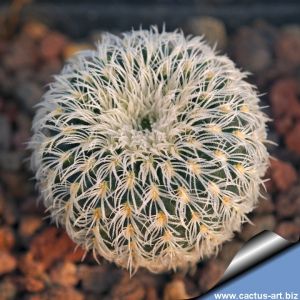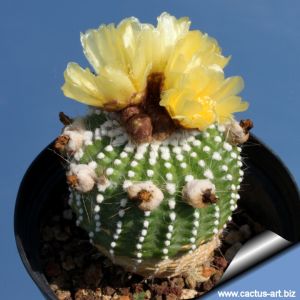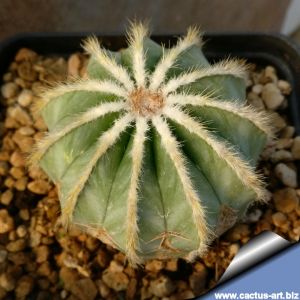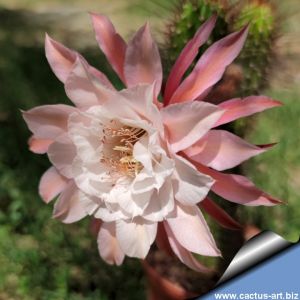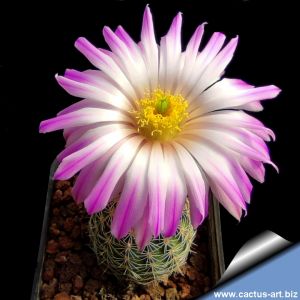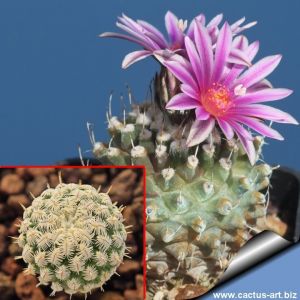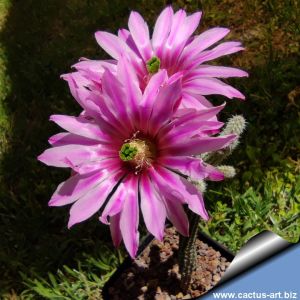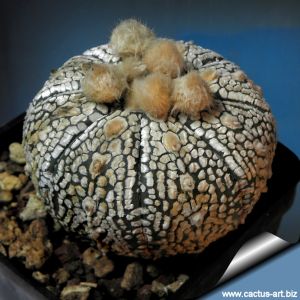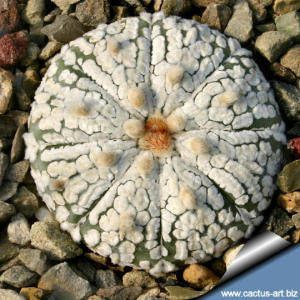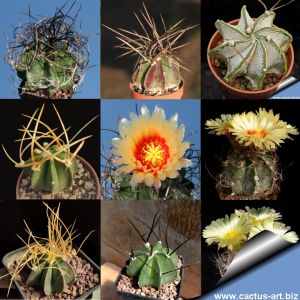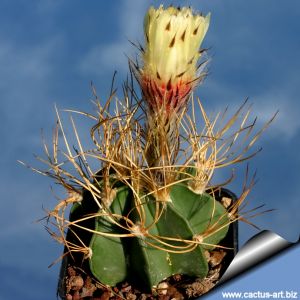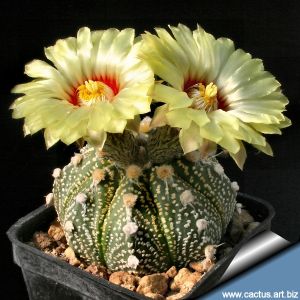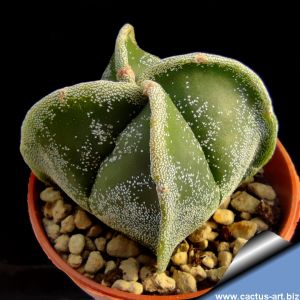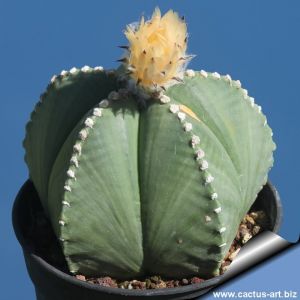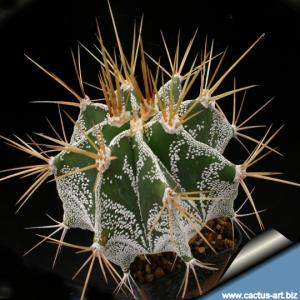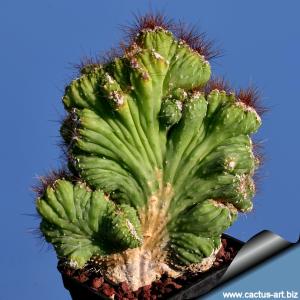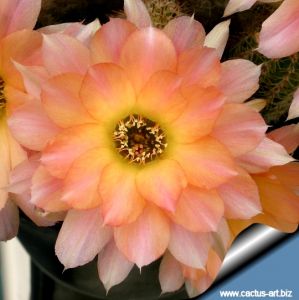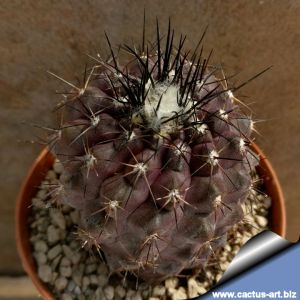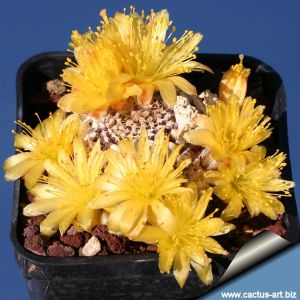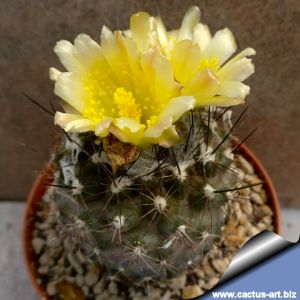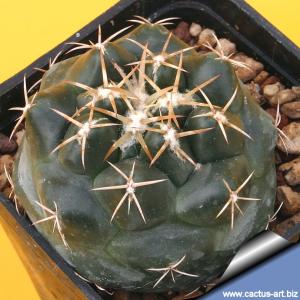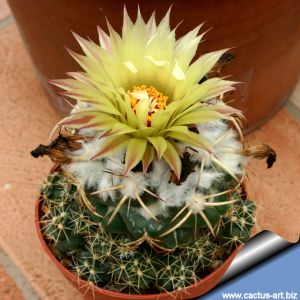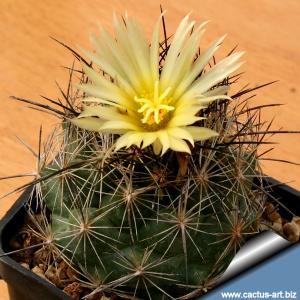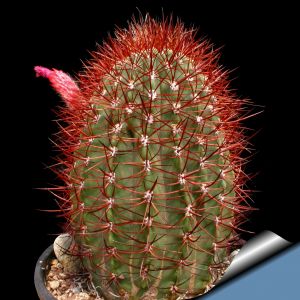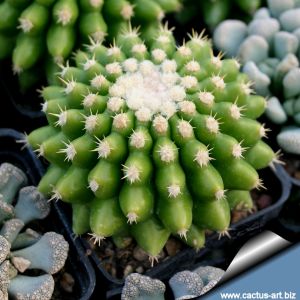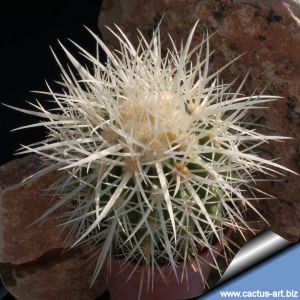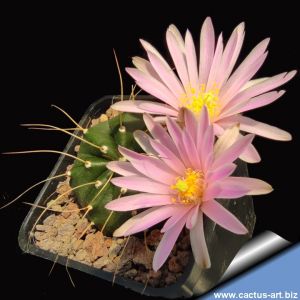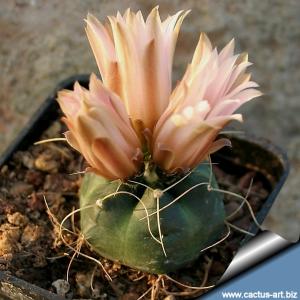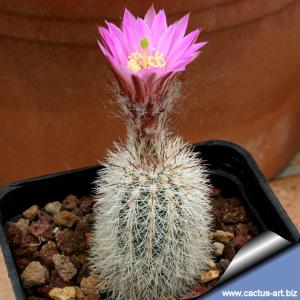-
1
Juvenile specimens initially have short spines, but as the plants grow, they form completely thornless areoles. Adult specimens are completely nude and particularly beautiful. RARE!!!
-
2
Flower 16 cm (Pisac x Orange California)
-
3
The petals are yellow with red median line, variable (but always stunning). This cultivar is also known as "FIRECHIEF", "MARDI GRAS", "FLAMETHROWER" and "FLAMBEAU". Native to the USA, it is similar to "SOM AEY", a rare Thai hybrid.
-
4
Crazy flowers that vary with each bloom. Inner petals from entire to thin and deeply thoothed, dull orange yellow with a lighter base. The pinkish to light purple outer petals are only visible when the inner petals are thoothed.
-
5
-
6
Rare form with golden-yellow spines resembling those of Eriocactus, contrasting sharply with black-spined varieties. It grows on quartz outcrops in Brazil (Minas Gerais), between 700–1,100 m, among
rocks.
-
7
Exquisitely crafted miniature cactus. Its dense, appressed spines create such perfect embroidery that the stem feels smooth to touch. Adorable pink flowers crown what is undoubtedly one of nature's most perfect small-scale creations.
-
8
NOT ROOTED CUTTING (1 segment). Selected clone with very long and flexible spines. It blooms easily even when small. Beautiful plant.
-
9
"DAY DREAM" is one of the most sought after Gymnocalycium cultivars. The thornless body is dark purple. Transversal strips of emerald green on the ribs create an extraordinary contrast. If exposed to the sun it will tend to have a more homogeneous color.
-
10
Interesting hybrid that combines the forms of A. ornatum with unique onzuka designs pattern. Very nice.
-
11
Dark olive-brown stem, very flat, growing at ground level. Short spines pressed against the body. Beautiful plant but very slow growing.
-
12
A special form with only 5 ribs — a rare trait in Astrophytum asterias and highly sought after by collectors.These selected specimens also display bold SUPERKABUTO-style markings. No two are alike.
-
13
-
14
-
15
A rare, entirely spineless form, presumed to be a mutant of Echinofossulocactus albatus. The pale green stem bears delicate, subtly wavy ribs divided into short, elongated tubercles.
-
16
One of the smallest cacti on Earth: a flattened greyish olive-green button atop a short, fleshy root anchoring it to rocky crevices. Spineless white areoles form spiral patterns, with pale cream flowers emerging from the center.
-
17
Blossfeldia mizqueana is among the smallest cacti in the world, featuring a flattened, coin-like body. It originates from rocky fissures at high elevations in Bolivia’s Mizque Province. 1,2-1,6 mm. OWN ROOTS. Seed grown, flowering size. VERY RARE!!!
-
18
Pelecyphora aselliformis (commonly known as the “Hatchet Cactus”) is one of the most renowned cacti for its uniquely shaped stem. The f. cristata form diverges by developing a fan-shaped crest up to 10 cm (or more) wide with age.
-
19
Hybrid Astrophytum caput-medusae feature larger yellow and green tubercles that take on a lovely orange hue in winter, exhibiting vigorous and sturdy growth. Grafted specimens, truly stunning.
-
20
Exceptional plants grown in Ø 6.5 cm pots, cultivated in full sun and showing stunning spination. Flattened, dark brown body with recurved, downward-pointing spines closely appressed to the stem. An opportunity not to be missed!!!
-
21
-
22
This is one of the most distinctive Rebutias, and is very hard to obtain. The flowers are yellow with a lovely hue of custard-powder, and are relatively large for so tiny a plant ... ... but is relatively hard to grow.
-
23
Stems of very dark green to nearly black-purple contrast sharply with long, slender white areoles. Short, comb-like spines start red and turn brown, making this cactus exceptionally striking even without flowers.
-
24
L. principis is one of the most distinctive, and fascinating cacti with long glaucous-green tubercles, tipped by equally long papery spines, it is unlike anything else. It is slow-growing and has a tuberous root.
-
25
OWN ROOTS ! This is a free offsetting small form of E. grusonii that is covered by yellowhish-white wool with short yellow spines. The rib structure is not yet apparent, and they have pronounced tubercles making them look superficially like Mammillaria.
-
26
The form "incahuasii", with greener and thinner stems, branches profusely and forms large clumps with more than 100 heads. The flowers are a deep purple and very showy.
-
27
Maihuenia poeppigii is a beautiful and unusual cactus from Patagonia that forms dense cushions up to 1 m in diameter. It is a surprisingly moisture and frost-tolerant cactus. It can also be grown anchored without soil on a roof (like for the sempervivums)
-
28
-
29
Slow-growing clumping cactus with soft flattened stems and dense, pale yellow spines with dark bases (up to 120 per areole), arranged in overlapping series. Short, fine, and slightly pubescent — a charming species.
-
30
-
31
Coryphantha Wohlschlageri is a small cactus with dark green olive green stems 3 to 5cm and the same diameter. The intensely egg-yellow flowers are 5 to 6 cm in diameter and silky.
-
32
Flower up to 12 cm wide. Inner petals bright magenta and deep vermilion, with pale magenta edges; outer petals dark red. Throat marked by a yellowish ring. Filaments dark red. Inspired by Pele, Hawaiian goddess of volcanoes, lava, and flame.
-
33
-
34
Seed plants selected for the variegated body. Very beautiful and strange. Variables.
-
35
Ferobergia is made by crossing Ferocactus and Leuchtenbergia. Back cross means that a Ferobergia has been pollinated back with a Ferocactus. These hybrids look more like Ferocactus, with short tubercles and hooked spines. They are quite variable.
-
36
Grown from seed with its own typical carrot-like tap root. 3 years old seedlings. Rare.
-
37
The flowers are truly remarkable, with cream-colored inner petals and striking avocado-green outer petals. A rare and distinctive combination that makes this hybrid instantly eye-catching.
-
38
Delicate glass-like spines intertwine into feathery frost patterns,
encasing the plant in perpetual winter. A living snowflake that defies
melting - exceptionally rare and mesmerizing under any light.
-
39
Notocactus scopa f. inermis (forma mostruosa) has spineless areoles with a short white wool, they are arranged geometrically and contrast with the stem. It’s very different from the common long and dense spiny form, in age it forms nice clumps.
-
40
Notocactus magnificus f. albispina is a rare form with silky white spines. The areoles are very close together and form a solid line along the edge of the rib. It is an odd and nice plant. Often young plants splits open at the base (see photo nr. 3)
-
41
-
42
Echinocereus sciurus subs. floresii, also known as Echinocereus floresii produces bright pink flowers up to 5 cm long and 7 cm wide the sides of the plant, well below the stem tips.
-
43
Turbinicarpus mombergeri is a naturally occurring hybrid between T. pseudopectinatus and T. laui. This plant pass a pectinate-plumose spine stage in which they are already floriferous. Most of the plants in time develop longer spines. It is quite variable
-
44
-
45
SUPERKABUTO classical form. Diameter 4-5 cm, seed grown about 5 years old (own roots never grafted).
-
46
Esemplari selezionati di A. asterias cv. SUPERKABUTO, solo piante con grandi macchie bianche e disegni particolari. Diametro 4-5 cm, piante da seme di cica 5 anni di età su radici proprie.
-
47
A curated mix of Astrophytum capricorne — a highly variable and strikingly beautiful species. Each plant is unique, showcasing diverse stem colour and mottlings, textures, and spines colors. An interesting selection at an affordable price.
-
48
A cactus of striking beauty and originality, featuring a green body adorned with long, twisted golden spines. Its large yellow flowers with a vivid red throat enhance its unique charm.
-
49
AS-CAP hybrids – Cross between A. asterias (mother) × A. capricorne (pollen donor). Large flowers with pearl-yellow petals and fiery red throat, ribs more pronounced than pure asterias but with short spines. A balanced blend of both species’ best traits.
-
50
Beautiful selected specimens with tetragonal growth (form quadricostatum), featuring faintly dotted epidermis that forms intricate patterns. The visual effect is elegant and refined.
-
51
Beautiful form that only deviate from the well-known typical form for lacking or mostly lacking white flecks, giving a bright green colour. It is by some considered an extreme form of the subspecies potosinus.
-
52
The Astrophytum ornatum is the largest and easiest to grow and also the fastest of the Astrophytums. Spherical when young to columnar when mature, some specimen develop nice twists with age.
Ribs have characteristic cross bands of wooly scales.
-
53
5,5 cm Ø. This is a slow growing and attractive plant that forms myriads of sculptural monstrous and crested shapes and woolly areoles. It is strong and easy to grow.
-
54
-
55
Plant with a large tap-root, connected to the stem by long slender neck. Seedlings naturally produce the huge tap root, starting from germination, i.e. before the plant stem becomes mature.
-
56
It is the smallest of the Copiapoa which begins to flower when it is only 1-2 cm in diameter. Slowly over time it forms many small heads. Stem soft brown whit minute spines, yellow flower and large tuberous root.
-
57
-
58
Coryphantha elephantidens is characterized by large, bluish-green, mammilliform tubercles and stout, curved, tusk-like central spines. It blooms at the apex with large yellow flowers in summer.
-
59
A cactus with a unique look! Blue-green "elephant skin" tubercles and tusk-like spines, topped with yellow blooms. The "prolifera" form is a burst of life: it pups abundantly, creating dense clumps quickly.
-
60
-
61
Cumarinia odorata was described as Coryphantha odorata by Bödeker in 1930, transferred into the genus Neobessaya by Werdermann and thence to the new genus Cumarinia by Knuth which, in turn, was reduced to a sub-genus of Neolloydia by Backeberg in 1942.
-
62
It's specific name comes from old Greek and means "red spine" for the colour of its clusters of spines. It's a barrel type of cactus and stay globular during a long period before becoming shortly column-shaped.
-
63
-
64
The Echinocactus grusonii v. albispinus looks just like a regular golden barrel but the spines are all glassy-white instead of yellow.This is a very nice plant.
-
65
This unique and unmistacable species has plump, soft, flattened or globose , dark green stems remenbering an unripe tomato. Large pink flower open in spring. The thick tuberous root requires adequately sized pots.
-
66
E. knippelianus v. krugeri is a miniature form with a plump green body, soft, thin, bristly, and curly spines. The flowers - often larger than the plant itself - are whitish or flesh-colored at the center.
-
67
Small clump-forming species. Heavy bloomer, it starts producing flowers when still very young. Flowers bright pink in sping. Grows together with Mammillaria wrightii v. wilcoxii.
-
68
It is a very untypical Echinocereus that does not take on the usual hedgehog shape. It is long and vine-like with slim, pendant sprawling stems, usually tangled with many branches up to 250 cm long. Rare in cultivation. Beautiful long orange-red flowers.
-
69
-
70
The long tubed flowers are a beautiful deep red. They bloom from April through June, and are very showy.
-
71
Solitary or few branche cylindrical stems. Radial spines, straight or slightly curved, lie close in two nearly pectinate series, white, beige, dull pink, brown, or purplish-black. Central spines often absent. Fragrant dark-purple flowers, 5–7 cm wide.
-
72
This is a "must have" plant for any collection, its attractiveness is in the unique pink and violet colour and density of its spines.

